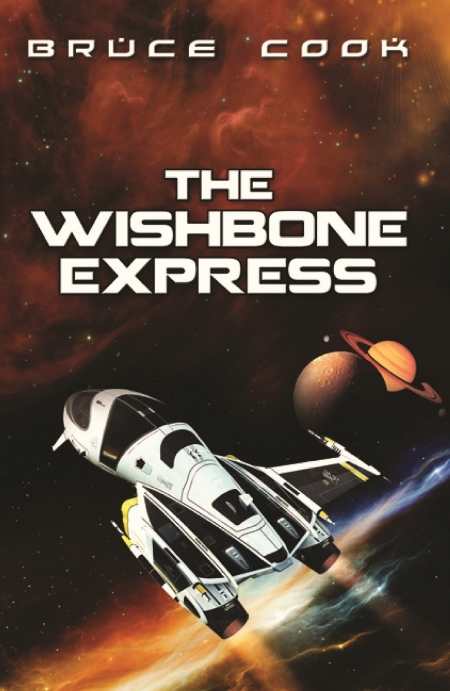The Wishbone Express
Take two parts humor, one part physics, add a dash of faster-than-light travel, and shake well.
The galaxy envisioned in The Wishbone Express is full of nonhuman life, peril, laughs, and surprisingly plausible science. With a fast pace and comedic timing, the humor and science blend to create an exciting adventure.
The Wishbone Express is set primarily on a sleek spacefaring yacht. The co-captains, Randy Henson and Bill Jenkins, are hired to take a lawyer, an endangered witness, and a bodyguard to a trial on the distant planet Philcani-tu. Along the way, they fight against many dangers—assassins, police, sabotage, kamikaze ships, and more.
Henson and Jenkins are a resourceful pair, good at thinking on their feet, constantly dodging attacks with creative uses of astrophysics. The other main characters are the generally milquetoast lawyer; the wiry, mysterious, and morally ambiguous Clawron; and a toothy, red, otter-like creature called the wajinda.
Author Bruce Cook, who has a good ear for funny dialogue and solid comedic timing, keeps the pace light and fast throughout. He also knows when to switch the focus to action, and there’s no shortage of that. Cook’s style is reminiscent of Harry Harrison’s less serious works, falling somewhere between The Stainless Steel Rat and Bill, the Galactic Hero.
Despite the predominately humorous style, there are moments of surprising seriousness. There’s a scene in which Clawron tries to drug and have sex with Jenkins. It’s rare in books, especially in science fiction, to find a scene in which a woman essentially attempts to rape a man—an attempt that Jenkins evades. Cook handles this surprising scene with appropriate weight.
While some science-fiction authors are hard-liners on scientific plausibility, insistent on remaining faithful to known physics, authors of lighthearted science fiction are usually more concerned with funny scenarios than with real science. Cook manages to incorporate reasonable theory and rational solutions without killing the action or comedy in the process. This balance is the best part of The Wishbone Express.
Characterization, however, could be improved. Henson and Jenkins feel very much like one character in two bodies, only truly distinct from one another in a few instances. Cook could have managed most of their actions with one character or one protagonist and a subordinate. An additional problem is the lack of a clearly defined antagonist. Though Henson and Jenkins fight constantly against enemy ships and various traps, the reader has no face or name to put to the aggression.
Even at 400-plus pages, it’s a pretty quick read due to a large font size and lots of white space. The cover art, a crucial element in a science fiction book, contains an illustration of a ship that appears, at first glance, disproportionate: one wing is foreshortened.
Overall, Cook succeeds in making an enjoyable romp. The book is a lot of fun for fans of science-fiction adventure.
Reviewed by
Jason Henninger
Disclosure: This article is not an endorsement, but a review. The publisher of this book provided free copies of the book and paid a small fee to have their book reviewed by a professional reviewer. Foreword Reviews and Clarion Reviews make no guarantee that the publisher will receive a positive review. Foreword Magazine, Inc. is disclosing this in accordance with the Federal Trade Commission’s 16 CFR, Part 255.

